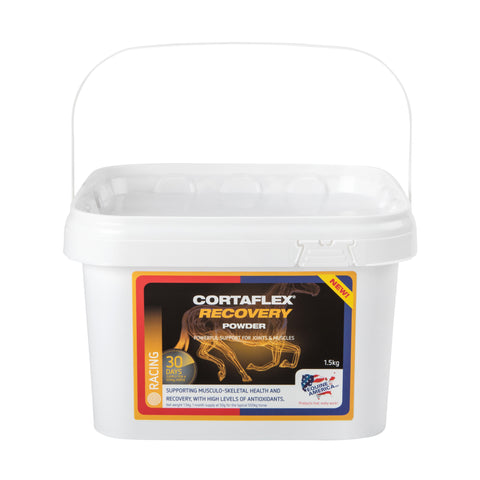Cortaflex Recovery Ingredients

Cortaflex Recovery – What’s in it?
We are very excited to launch our new product Cortaflex Recovery. Cortaflex Recovery aims to support your horses to reach new heights, with targeted nutrition to support preparation, performance and recovery.
Equine athletes undergo challenges and stresses with intense exercise, stabling and frequent travel. Often due to their regime their diet may be high in concentrates with little turnout to pasture. For these reasons they may need targeted nutritional support to help them to stay healthy and well and perform at their best. Let’s have a closer look at some of the key ingredients that can support the performance horse to reach their genetic potential!
Inflammation is the body’s natural reaction to injury or infection and is characterised by heat, swelling, redness and pain. Whilst inflammation is necessary to promote healing and repair, excessive and long-term inflammation can be damaging. For example, excessive inflammation in the joint can cause damage to the cartilage.
Boswellia
Boswellia is a plant that has been used for centuries in Asian and African medicine. The resin from Boswellia is also known as frankincense. Boswellia contains a number of biologically active Boswellic acids, and the most widely studied is AKBA (acetyl-11- keto-beta-boswellic acid).
AKBA reduces the release of pro-inflammatory cytokines, which can cause cartilage breakdown and joint pain. Cytokines are immune molecules that destroy organs/tissues during a large inflammatory response.
Cortaflex Recovery contains high levels of Boswellia at 7000mg per 50g serving to provide powerful support for the horse’s own anti-inflammatory processes.
Curcumin
The active ingredient in turmeric is curcumin, which provides antioxidant support as well as anti-inflammatory support. Black pepper is added, to provide the active compound piperine, to improve absorption of curcumin by the horse.
Antioxidants:
Antioxidants mop up the harmful free radicals preventing oxidative stress and damage to cells. Antioxidants are natural compounds that can be made in the body or found in the diet. Free radicals are unstable molecules. Free radicals are naturally produced by the body during normal exercise, but excessive free radicals produced during intense exercise, illness and stress can cause oxidative damage to cells. Cortaflex Recovery contains a powerful range of antioxidants, including Vitamins E and C, as well as beetroot, grapeseed extract and rosemary. These potent antioxidants help to mop up the free radicals produced during intense exercise and stress, which otherwise cause damage to cells and a reduction in performance and a delay in recovery.
Chondroprotective Ingredients:
Lameness is a common problem in horses with joint disease frequently being the cause.
Collagen
Collagen is one of the most abundant proteins in the body, found in skin and connective tissue, including ligaments and tendons and is needed to produce the water-based matrix or structural framework of the cartilage, to help give it strength and elasticity.
Equine America uses a sustainable and ethical source of marine collagen.
Hyaluronic Acid
Hyaluronic Acid is a key glycosaminoglycan (GAG) which helps to maintain the viscosity of the joint fluid, to lubricate the joint and act as a shock absorber. When a joint is damaged and swollen, the synovial membrane can only produce a limited supply of hyaluronic acid, resulting in dilute poor quality joint fluid.
Glutamic Acid
Glutamic Acid is an amino acid present in joints and cartilage and is essential for proper joint function. Glutamic acid is a building block of glucosamine. Cortaflex provides the building blocks for horses to produce their own glucosamine.
Glucosamine has 3 important roles in supporting joint health: 1. stimulating production of the proteoglycans which help produce the strong, elastic, shock absorbing properties of the collagen matrix in the cartilage; 2. Reducing degradation of cartilage; 3. Antioxidant properties and helps promote a normal inflammatory response.
Glycine
Glycine is another important amino acid for joint health, as it is one of the most abundant amino acids in collagen. Glycine is also important in the horse’s own production of key antioxidants such as glutathione, as well as playing a role in energy production.
Vitamins and Minerals
Copper
Copper plays key roles in connective tissues (tendons and ligaments) of horses. The health of connective tissue is vital in maintaining soundness in performance horses. Copper also is important in maintaining energy production, via its role in haemoglobin, and is a key co-factor in the synthesis of key antioxidants.
Vitamin B12
B vitamins are essential to a horse’s health. Bacteria in the hindgut produce some B Vitamins, while others are gained from fresh green forage, or fortified concentrate feeds in the horse’s diet. Many horses get all the B Vitamins they need from these sources, but those who receive limited grazing, or low intakes of concentrate feed, horses recovering from illness or in high levels of work with an intense competition program, can benefit from additional supplementation.
Vitamin B12 also known as cobalamin, promotes red blood cell production and is involved in protein metabolism and in the metabolism of fats and carbohydrates for energy production.
Vitamin C
Vitamin C is involved in the transfer of iron and is vital to the normal formation of collagen, an essential structure of skin and connective tissue including tendons and ligaments. Vitamin C also supports the immune system and is important for lung health. Although horses can make their own Vitamin C, there are occasions where requirements increase or the ability to synthesise their own Vitamin C may be compromised or reduced, such as stress from intense work, frequent travel or illness.
Omega 3 Fatty Acids
Omega 3 Fatty acids precursors are provided by full fat linseed (flax). Omega 3 Fatty acids are vital to support the horse’s own anti-inflammatory processes, as well as playing key roles in the immune system and skin and coat health.

 Skip to content
Skip to content

